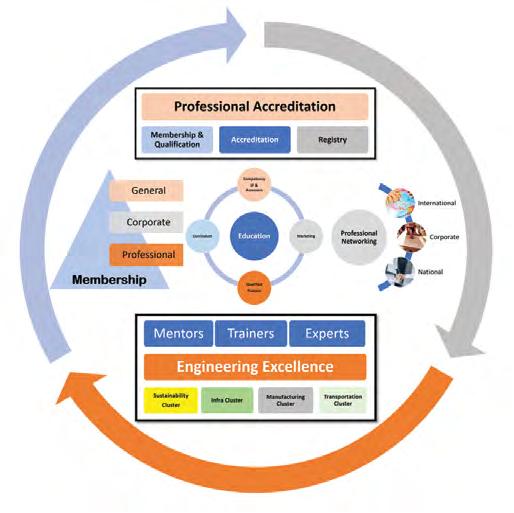
3 minute read
New directions for engineers in a disruptive world Dr Richard Kwok, President of The Institution of Engineers, Singapore, sets out his vision for IES
IES will continue to work on building an inclusive engineering ecosystem by enhancing training, accreditation, networking and promoting enterprises.
TSE: In your inauguration speech, you spoke of four strategic initiatives that you will be adopting, as IES President, to drive greater excellence. Could you elaborate further?
RK: As we enter the post-pandemic phase, it is essential for IES to provide our engineering community with maximum support to overcome immediate challenges while continuing to move towards our long-term goals. With this in mind, we have laid down four strategic initiatives for the next two years: • To enhance opportunities for continuous professional development and upskilling for engineering professionals - through the IES Academy. • To increase recognition of engineering professionals by establishing mutual recognition with international engineering institutions to promote cross-border mobility of engineers. • To attract more engineers to join the IES family by engaging and adding value to our stakeholders - making
IES the partner of choice. • To drive excellence in various engineering sectors in
Singapore through our Technical Committees (TCs). To realise these goals, we have also identified three key action steps or what I call ‘DiSH’: • ‘Di’ stands for digitalisation - our aim is to integrate all technical resources and business processes to make information more accessible for our members and key stakeholders. This will elevate our administrative standards and operational productivity. • ‘S’ stands for standardisation - where work processes will be standardised to enhance organisational output, efficiency and transparency. • ‘H’ for harmonisation - which involves synchronising all existing committees and initiatives to achieve maximum synergy across all functions at IES.
TSE: What are some of the criteria necessary to nurture the next generation of engineers?
RK: Awareness, upskilling and recognition are critical components in nurturing the next generation of engineers. These areas are covered in our four strategic initiatives. Awareness is important as rapid technological advancement is creating lots of new job roles in engineering that our younger generation may not know about. We hope to raise, amongst our youth, awareness of the fact that getting into engineering is the perfect launchpad to an exciting career. We will also continue to work with our partners to show students the vast range of career possibilities that engineering offers and help them start thinking, at a young age, about engineering as a career choice. Upskilling is another key area. Technological changes mean that skillsets required for engineers are rapidly and constantly changing. Our initiative to enhance upskilling for engineering professionals, including new entrants to the field, will ensure that they can succeed in the fastpaced, disruptive and competitive environment. Recognising engineers and their contributions is another important aspect, as young people are looking for a career with clear, strong opportunities for progression. We will continue to introduce or strengthen existing professional accreditation programmes to support young engineers in moving from one role to another, according to their career aspirations.
TSE: Any other information that you wish to provide?
RK: Setting clear goals is only half the battle won. Identifying a clear path and formulating actionable steps are just as critical. With the support of the IES Council, I have developed a holistic action plan beginning with reorganising the IES Council to oversee five different core functions and move towards our goals as one synergistic team. IES will also be setting up a legal advisory panel and a finance committee to establish a robust corporate governance system that strengthens checks and balances for all our processes and compliance regulations. Above all, I am thankful to our members for giving me the opportunity to serve as IES President for the next two years. I have enjoyed being an engineer for the past 47 years as it has allowed me to add value to the society. With their support, I am committed to leading IES forward so that more engineers can be in the best positions to
create a positive impact on our lives and our future.
The five core functions of IES are Professional Development and Education (Group 1), Professional Accreditation & Recognition (Group 2), Engineering Excellence (Group 3), Professional Engagement (Group 4) and Membership Relations (Group 5).




